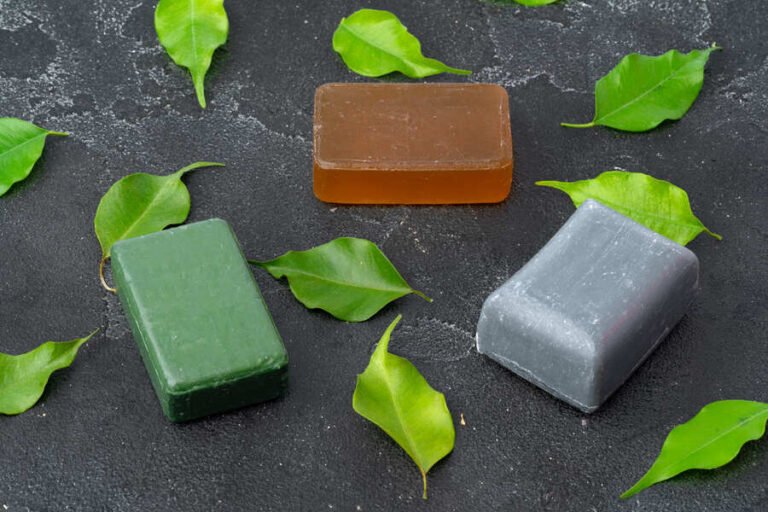Ready to take your skincare routine to the next level? Look no further than the powerful duo of vitamin C and salicylic acid.
These game-changing ingredients have the potential to transform your skin, from brightening and reducing dark spots to unclogging pores and treating acne.
In this article, we'll guide you through the benefits, application, and best practices of incorporating vitamin C and salicylic acid into your daily regimen.
Get ready to liberate your skin and achieve a healthier, more radiant complexion.
Key Takeaways
- Vitamin C and salicylic acid have different benefits and are suited for different skin types.
- Vitamin C brightens the skin and stimulates collagen production, while salicylic acid unclogs pores and prevents acne.
- It is important to patch test and start with low concentrations of each ingredient.
- Sunscreen should be used when using vitamin C, and the products should be applied at different times of the day.
The Benefits of Vitamin C and Salicylic Acid
You will experience numerous benefits when incorporating vitamin C and salicylic acid into your skincare routine. Choosing the right vitamin C and salicylic acid products is essential for achieving optimal results.
Vitamin C is known for its ability to brighten dull, tired-looking skin, reduce the appearance of dark spots and hyperpigmentation, and even out skin tone. It also stimulates collagen production and protects the skin from sun damage and environmental stressors.
Salicylic acid, on the other hand, treats acne by unclogging pores and reducing inflammation. It exfoliates the skin and promotes cell turnover, making it an excellent choice for oily or acne-prone skin types.
How to Choose the Right Vitamin C and Salicylic Acid Products
When selecting the right vitamin C and salicylic acid products for your skincare routine, it's crucial to consider your specific skin type and concerns. Choosing the right products will help you achieve the desired results without experiencing potential side effects.
For vitamin C, opt for a serum or lotion formulation that contains a stable form of vitamin C, such as L-ascorbic acid or ascorbyl glucoside. Look for salicylic acid products that have a concentration of 0.5% to 2% to effectively treat acne and unclog pores.
It's important to read product labels and ingredients to ensure they're suitable for your skin type and concerns. If you have sensitive skin, consider starting with lower concentrations and gradually increasing as tolerated. Remember to always patch test new products and consult a dermatologist if needed.
Step-by-Step Guide to Incorporating Vitamin C and Salicylic Acid in Your Skincare Routine
To effectively incorporate vitamin C and salicylic acid into your skincare routine, start by cleansing your skin and then applying a small amount of each product. Choosing the right vitamin C and salicylic acid products is essential to maximize their benefits.
Look for vitamin C serums that contain a stable form of vitamin C, such as ascorbic acid or L-ascorbic acid. For salicylic acid, opt for products with a concentration of 0.5% to 2%.
After cleansing, apply the vitamin C serum to your face and neck, allowing it to absorb before applying other products. In the evening, apply the salicylic acid product to your face or affected area. Remember to follow up with a moisturizer to prevent dryness.
Best Practices for Applying Vitamin C and Salicylic Acid
For optimal results, incorporate vitamin C into your morning skincare routine and apply salicylic acid in the evening.
When choosing the right concentration of vitamin C and salicylic acid, it's important to consider your skin type and sensitivity. Start with a lower concentration and gradually increase as needed.
There are common misconceptions about using vitamin C and salicylic acid, such as the belief that higher concentrations will yield better results. However, using too high of a concentration can actually cause skin irritation and dryness.
It's also important to note that vitamin C and salicylic acid can be used together, but it's best to apply them at different times to avoid potential interactions.
Potential Risks and Precautions When Using Vitamin C and Salicylic Acid
Be mindful of the potential risks and precautions associated with using vitamin C and salicylic acid in your skincare routine. While these ingredients can provide numerous benefits for your skin, it's important to understand and take necessary precautions to avoid any potential side effects.
Here are three important things to consider:
- Potential side effects: Both vitamin C and salicylic acid can cause skin irritation, dryness, and allergic reactions in some individuals. It's important to monitor your skin for any signs of discomfort and discontinue use if necessary. If you experience severe or persistent side effects, consult a dermatologist.
- Proper storage: To ensure the effectiveness and stability of your vitamin C and salicylic acid products, store them in a cool, dry place away from direct sunlight. Exposure to heat and light can degrade these ingredients and reduce their efficacy.
- Proper handling: When using vitamin C and salicylic acid, follow the product instructions regarding frequency of application and avoid using excessive amounts. Overuse can lead to dryness, irritation, and other adverse effects on the skin.
The Difference Between Vitamin C and Salicylic Acid
While both vitamin C and salicylic acid offer unique benefits for your skin, understanding the difference between the two is essential in determining which ingredient is best suited for your skincare needs.
Vitamin C is a water-soluble antioxidant that brightens the skin, fades dark spots, and stimulates collagen production. It's best suited for dull or aging skin types.
On the other hand, salicylic acid is an oil-soluble beta-hydroxy acid that penetrates pores, exfoliates dead skin cells, and prevents acne. It's best suited for oily or acne-prone skin types.
When used together, vitamin C and salicylic acid can provide a powerful combination that addresses multiple skincare concerns. However, it's important to note that using too much of these ingredients or using them too frequently can lead to potential side effects such as dryness, irritation, and increased photosensitivity.
It's recommended to start with a low concentration of each ingredient and to always follow product instructions for frequency of application. Additionally, it's important to patch test any new combinations of products before applying them to your entire face.
Combining Vitamin C and Salicylic Acid for Maximum Skincare Benefits
To maximize the skincare benefits, you can combine vitamin C and salicylic acid in your skincare routine. These two powerhouse ingredients work together to address multiple skin concerns and give you a radiant complexion. Here's how you can incorporate them for maximum effectiveness:
- Choosing suitable concentrations: When combining vitamin C and salicylic acid, it's important to select products with suitable concentrations. Start with lower concentrations and gradually increase as your skin becomes accustomed to the ingredients. This will help minimize the risk of irritation and ensure optimal results.
- Understanding pH levels: Both vitamin C and salicylic acid are pH-dependent, meaning their effectiveness can be influenced by the pH of the product. Look for products with the right pH levels to ensure that these ingredients can work synergistically and deliver their full benefits to your skin.
- Patch testing: Before incorporating any new combination of products into your skincare routine, it's essential to patch test first. Apply a small amount of the product on a discreet area of your skin to check for any adverse reactions or sensitivities. This step will help you determine if the combination is suitable for your skin and prevent any potential issues.
How to Incorporate Vitamin C and Salicylic Acid Into Your Morning Routine
When getting ready for your day, it's important to incorporate vitamin C and salicylic acid into your morning skincare routine. Using these two powerful ingredients together can provide numerous benefits for your skin.
Vitamin C brightens your complexion, reduces dark spots, evens out skin tone, stimulates collagen production, and protects against sun damage and environmental stressors.
Salicylic acid, on the other hand, unclogs pores, reduces inflammation, and promotes cell turnover, making it effective for treating acne.
There are some common misconceptions about using vitamin C and salicylic acid. One misconception is that they can't be used together. However, they can actually complement each other when used in the right way.
Another misconception is that vitamin C should only be used at night, but it can be incorporated into your morning routine as well. Just make sure to follow up with a broad-spectrum sunscreen to protect your skin from potential sensitivity to the sun.
How to Incorporate Vitamin C and Salicylic Acid Into Your Evening Routine
To effectively incorporate vitamin C and salicylic acid into your evening skincare routine, you should cleanse your skin and then apply the products in a specific order. Here are three important steps to follow:
- Cleanse your skin:
Start by washing your face with a gentle cleanser to remove dirt, oil, and makeup. This will help prepare your skin for the application of vitamin C and salicylic acid.
- Apply vitamin C:
After cleansing, apply a few drops of vitamin C serum to your face and neck. Gently massage it into your skin until fully absorbed. Vitamin C is best applied in the evening to protect your skin from free radicals and promote collagen production.
- Use salicylic acid:
Once the vitamin C serum has fully absorbed, apply a small amount of salicylic acid product to your face or any acne-prone areas. Allow it to absorb before applying any other products. Salicylic acid helps unclog pores and reduces inflammation, making it ideal for evening use.
Remember to consider the pH of your products when using vitamin C and salicylic acid. Additionally, if you're pregnant, it's important to consult with your healthcare provider before incorporating these ingredients into your skincare routine.
Tips for Maintaining a Healthy Skincare Routine With Vitamin C and Salicylic Acid
As you continue with your skincare routine, remember to regularly incorporate vitamin C and salicylic acid for optimal results. To maintain a healthy skincare routine with these ingredients, it's important to focus on maintaining the pH balance of your skin. Look for products that are specifically formulated to have a pH level that's suitable for your skin type.
When it comes to choosing recommended brands for vitamin C, you can consider brands like Drunk Elephant, Sunday Riley, and The Ordinary. For salicylic acid, some popular brands include Paula's Choice, Neutrogena, and CeraVe. Remember to patch test any new products and start with a low concentration to minimize the risk of irritation.
Frequently Asked Questions
Can I Use Vitamin C and Salicylic Acid Together in My Skincare Routine?
Yes, you can use vitamin C and salicylic acid together in your skincare routine. They can be a powerful combination for brightening skin, reducing acne, and improving overall skin health. However, there are alternative options if you prefer not to use them.
Can I Use Vitamin C and Salicylic Acid if I Have Sensitive Skin?
Yes, you can use vitamin C and salicylic acid if you have sensitive skin, but proceed with caution. Start with low concentrations, patch test, and consult a dermatologist. Alternatives include gentler exfoliants and soothing ingredients like niacinamide for sensitive skin.
Can I Use Vitamin C and Salicylic Acid if I Am Pregnant or Breastfeeding?
Yes, you can use vitamin C and salicylic acid during pregnancy and breastfeeding, but consult your doctor first. If you're looking for alternatives, consider gentle skincare ingredients like glycolic acid or niacinamide.
How Long Does It Take to See Results From Using Vitamin C and Salicylic Acid?
Want to know how long it takes to see results from using vitamin C and salicylic acid? The benefits of these ingredients for acne scars are noticeable in a few weeks, but consistency is key.
Can I Use Vitamin C and Salicylic Acid on Other Parts of My Body Besides My Face?
Yes, you can use Vitamin C and Salicylic Acid on other parts of your body besides your face. They provide similar benefits for the skin, such as brightening, exfoliating, and reducing acne. Remember to patch test and start with a low concentration.
Conclusion
Incorporating vitamin C and salicylic acid into your skincare routine can have a significant impact on your complexion.
Did you know that studies have shown that vitamin C can increase collagen production by up to 8 times? This means that by consistently using vitamin C products, you can help improve the elasticity and firmness of your skin.
Combine this with the pore-clearing and acne-fighting properties of salicylic acid, and you have a powerful duo for achieving a healthier, more radiant complexion.







